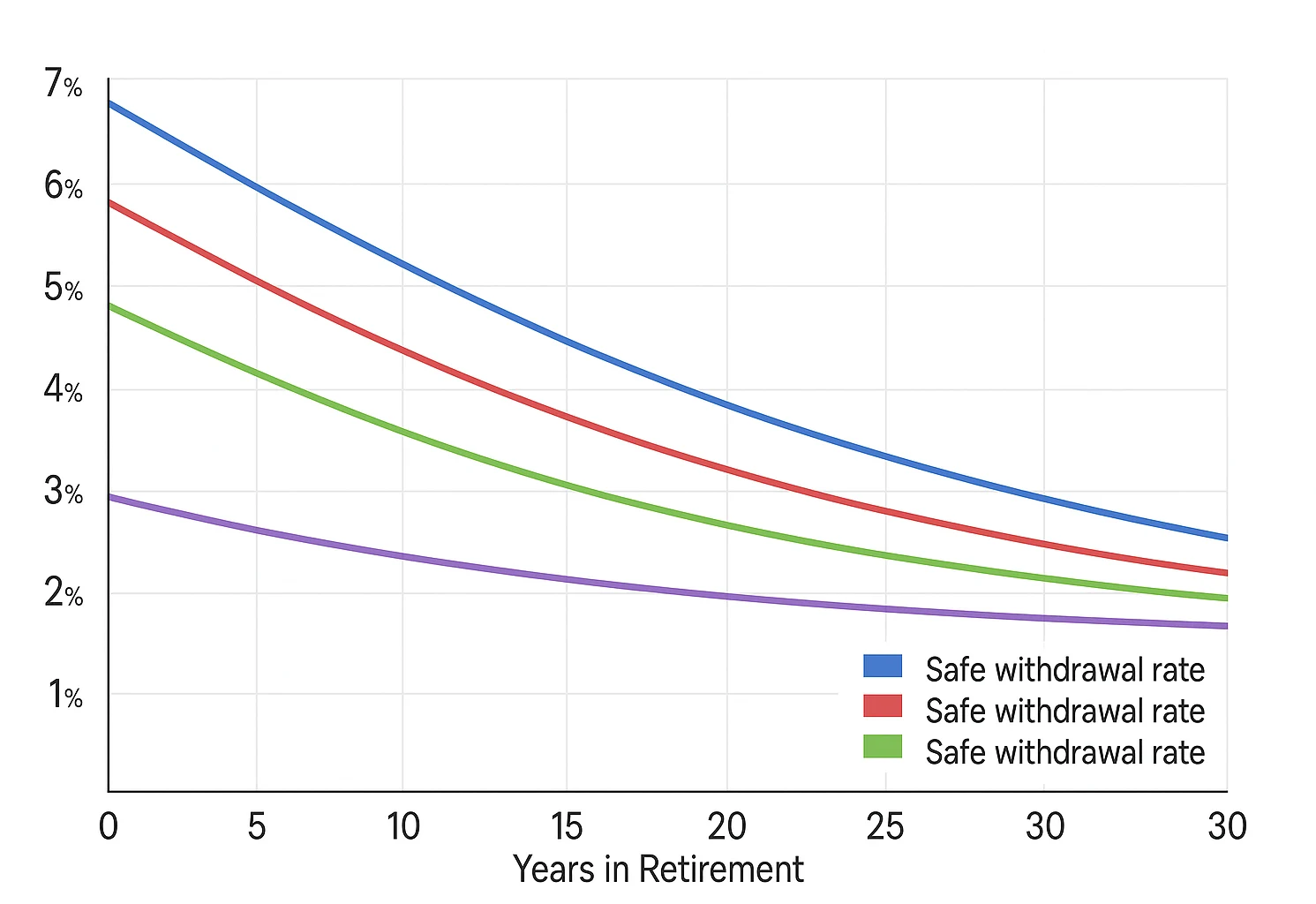
Picture yourself at 60, sipping coffee on a beach, free from work worries. But can $2 million make this dream a reality? Many aspire to learn how to retire at 60 with 2 million dollars, inspired by the Financial Independence, Retire Early (FIRE) movement and its focus on practical planning. Turning that vision into reality with a $2 million nest egg takes smart strategies, realistic expectations, and a clear path. In this guide, I’ll break down exactly how to make $2M work for a 60+ retirement with down-to-earth steps and real-life examples. From managing withdrawals to covering healthcare and taxes, I’ve got you sorted. Let’s jump right in! 🚀
Plan Your Retirement Now!Table of Contents
- Key Takeaways for Retiring at 60
- Can You Retire at 60 with $2 Million?
- How to Retire at 60 with 2 Million Dollars: Safe Withdrawal Rates
- Social Security: Timing Your Benefits
- Asset Allocation: Protecting Your $2 Million
- How to Retire at 60 with 2 Million Dollars: Your Step-by-Step Plan
- Interactive Retirement Simulator
- Frequently Asked Questions
- Summary: Your Path to Retire at 60 with 2 Million Dollars
Key Takeaways for Retiring at 60
- $2 Million Can Work: With smart planning, a $2M nest egg can support a comfortable retirement, provided expenses are managed wisely.
- Safe Withdrawal Rates: Using a 3.5% or 4% withdrawal rate helps your money last 30+ years.
- Budget and Healthcare Matter: Accurate expense forecasts, especially for healthcare, are critical for sustainability.
- Social Security Timing: Deciding when to claim benefits can significantly boost lifetime income.
- Stay Flexible: Regularly stress-test and adjust your plan for market shifts or unexpected costs.

Can You Retire at 60 with $2 Million?
Is $2 million enough to retire at 60? The answer depends on your lifestyle, expenses, health, and retirement duration. A well-managed $2 million portfolio can generate income for 30 years or more, making retirement at 60 achievable. For example, if you live on $80,000 annually, $2 million could last 25 years without growth. With reasonable returns, your money can stretch further.
Start with Your Lifestyle
Before crunching numbers, envision your retirement lifestyle. Will you travel globally ✈️, pursue hobbies, or relax at home? Each choice impacts your budget. Start by calculating your annual expenses.
Estimating Your Annual Expenses
Many retirees underestimate expenses. While commuting costs may drop, travel or healthcare costs often rise. To begin, list your current expenses and adjust for retirement. Here’s a breakdown:
- Housing: Mortgage, taxes, utilities, maintenance. Will you downsize?
- Food: Groceries, dining out.
- Transportation: Car costs, gas, public transit.
- Healthcare: A major expense, detailed below.
- Insurance: Life, auto, home.
- Entertainment: Hobbies, dining, gym memberships.
- Travel: Vacations or weekend trips.
- Taxes: Income, property, capital gains.
- Miscellaneous: Gifts, donations, emergencies.
Tip: Track spending for 3 months pre-retirement using an app or spreadsheet. Include “lumpy” costs like annual premiums. Suppose your target is $75,000 annually.
Your retirement budget aligns spending with your values. Be honest about needs versus wants.
Healthcare Costs: The Big Challenge 💊
Healthcare is a major wildcard before Medicare begins at 65. If you retire earlier, you’ll need private insurance via the Affordable Care Act (ACA) or COBRA. Premiums vary by state, income, and plan, ranging from $500–$1,500 monthly. After 65, Medicare reduces costs, but premiums, co-insurance, and supplemental plans (Medigap) add up. Long-term care, often uncovered, is another concern. For federal marketplace info, see Healthcare.gov.
Travel and Leisure Costs ✈️
Expect travel to increase in early retirement. Budget $5,000–$20,000 annually depending on how often and how far you go.
Accounting for Inflation 📈
Inflation erodes purchasing power. At 3% annually, $75,000 today becomes about $100,750 in 10 years. Your portfolio needs growth to keep pace.
How to Retire at 60 with 2 Million Dollars: Safe Withdrawal Rates
Your $2 million is like a well you sip from carefully. A safe withdrawal rate (SWR) determines how much you can take annually without depleting your portfolio. Let’s explore two common approaches.
The 4% Rule Explained
The 4% rule, based on historical research like the Trinity Study, suggests withdrawing 4% of your initial portfolio ($80,000 from $2 million) in year one, adjusting for inflation thereafter. Historically, this lasted ~30 years for balanced portfolios, but low returns or long retirements may require caution.
The 3.5% Rule for Extra Safety
For a 35+ year retirement, a 3.5% rate ($70,000 from $2 million) is safer, especially in uncertain markets.
Flexible Withdrawals for Resilience
Rigid withdrawals can backfire during market dips. Adopt dynamic spending: reduce withdrawals in bad years, increase in good ones to manage sequence-of-returns risk.

Social Security: Timing Your Benefits
Social Security can meaningfully ease the burden on your portfolio. Timing is critical.
Claiming Options: Early, Full, or Delayed
You can claim at 62 (reduced benefits), your Full Retirement Age (FRA, 66–67, full benefits), or delay until 70 (about an 8% annual increase). For example, if your FRA benefit is $2,500/month ($30,000/year) and you retire at 60, your portfolio covers $75,000 until 67. Then, Social Security reduces your withdrawal to $45,000, lowering your rate to under 3%.
Strategic Delaying
If your portfolio supports it, delaying Social Security is a guaranteed, inflation-adjusted income boost that reduces portfolio stress later.
Asset Allocation: Protecting Your $2 Million
In retirement, you need both growth and stability. Avoid being too conservative; inflation demands some growth over 30+ years.
Balanced Portfolio Approach
A typical allocation is 40–60% stocks (growth), 30–50% bonds (stability), and some cash (1–2 years’ expenses). Adjust for your risk tolerance.
The Bucket Strategy 🪣
Divide your portfolio into:
- Short-Term (1–3 years): Cash, CDs for immediate needs.
- Mid-Term (3–10 years): Bonds for income.
- Long-Term (10+ years): Stocks for growth.
Pull from Bucket 1 and replenish from others strategically to avoid selling low.
How to Retire at 60 with 2 Million Dollars: Your Step-by-Step Plan
Now, let’s combine these elements into a clear plan.
Step 1: Build Your Budget 📝
Create a detailed budget, distinguishing needs from wants. Include healthcare and inflation. Aim for $63,000–$70,000 annually, depending on Medicare status.
Step 2: Model Income Streams 📊
Calculate withdrawals ($75,000 = 3.75% of $2 million initially). Plan Social Security (e.g., $30,000 at 67). Consider part-time work or pensions to diversify income.
| Item | Annual Amount ($) | Notes |
|---|---|---|
| Projected Expenses | ||
| Housing | 10,000 | Taxes, insurance, utilities |
| Food | 12,000 | Groceries, dining |
| Transportation | 5,000 | Car, gas, maintenance |
| Healthcare (Pre-Medicare) | 15,000 | ACA, deductibles (until 65) |
| Healthcare (Post-Medicare) | 8,000 | Premiums, Medigap (from 65) |
| Travel | 10,000 | 1–2 trips |
| Hobbies & Entertainment | 6,000 | Golf, streaming |
| Miscellaneous | 5,000 | Gifts, emergencies |
| Total Expenses | 63,000–70,000 | Varies by Medicare |
| Projected Income | ||
| Social Security (FRA) | 30,000 | At 67 |
| Portfolio Withdrawal | 33,000–40,000 | Expenses minus Social Security |
| Withdrawal Rate | 1.65%–2.0% | Based on $2M |
Note: Adjust for inflation annually.
Step 3: Optimize Asset Allocation 🛡️
Use a 50/50 or 60/40 stock/bond split. Implement the bucket strategy and rebalance yearly.
Step 4: Plan Taxes 💰
Traditional IRA withdrawals are taxed as income; Roth withdrawals are tax-free. Consider Roth conversions in low-income years (60–73). Manage capital gains in taxable accounts.
Step 5: Address Healthcare
Research ACA plans for ages 60–64 and understand Medicare options (Parts A, B, D, Medigap) before 65. Budget for healthcare-specific inflation.
Step 6: Stress-Test Your Plan 🧪
Model scenarios like market crashes, 4% inflation, or living to 100. Use Monte Carlo simulations to assess risk.
Step 7: Stay Flexible 🔄
Review your budget, portfolio, and spending annually. Adjust for life changes or market shifts.

Interactive Retirement Simulator
Plan Your $2M-at-60 Scenario
Estimate how long your $2 million lasts based on your expenses and Social Security.
Enter valid details to see your projection.
*Assumes 5% portfolio growth and 3% inflation (historical averages, but markets vary). Consult a financial advisor.
Frequently Asked Questions
Summary: Your Path to Retire at 60 with 2 Million Dollars
To retire confidently at 60 on $2 million, budget accurately ($63,000–$75,000/year), use a 3.5%–4% withdrawal rate, time Social Security thoughtfully, keep a balanced allocation, and plan taxes. Stress-test for risks like inflation or market dips, and review annually.
Retiring at 60 with $2 million is achievable with discipline. For personalized advice, consult a fiduciary financial advisor. Your $2 million can unlock a life of freedom—enjoy the journey! 🥳
This content is for informational purposes only and not financial advice. Consult a professional before making financial decisions.

